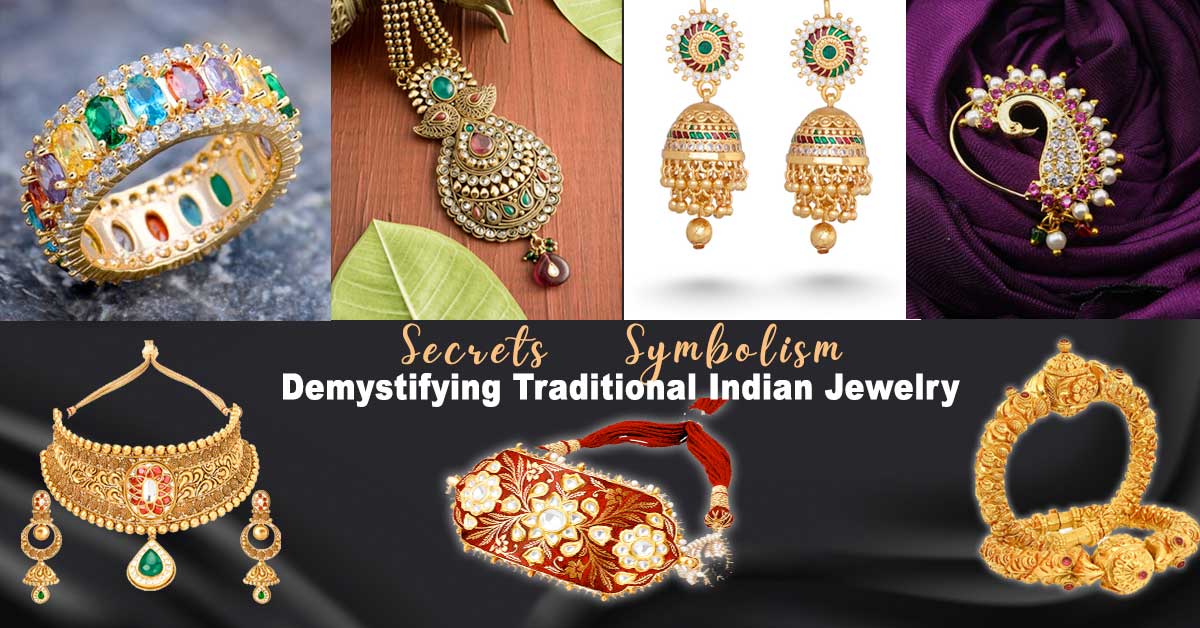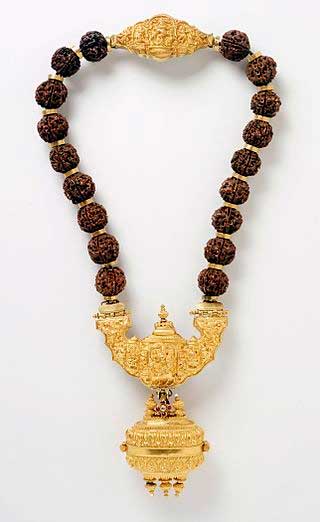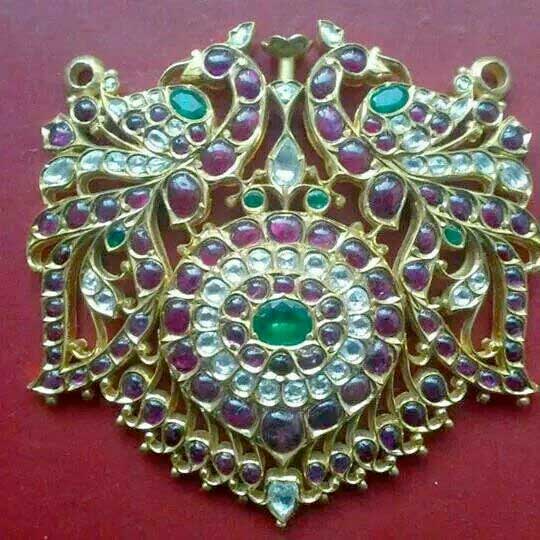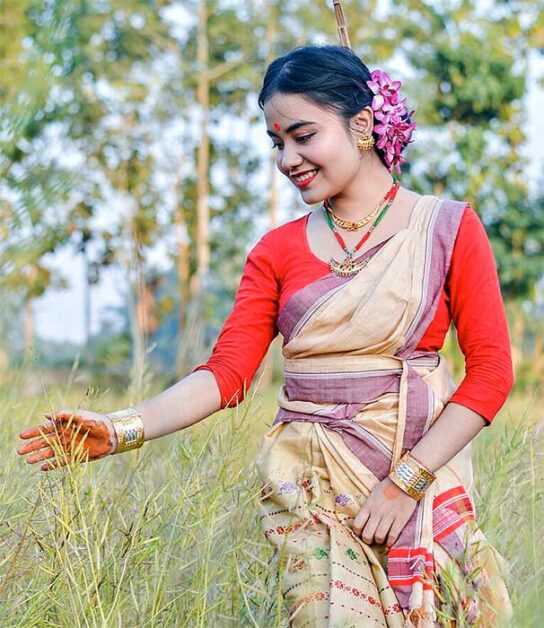Looking to add some glitz and glamor to your closet? Imagine a bride adorned in shimmering gold. Each piece whispering stories of prosperity and blessings. Or picture a holy man wearing sacred rudraksha beads. Traditional Indian Jewelry transcends mere adornment. It’s a captivating language woven into the fabric of Indian culture and tradition.
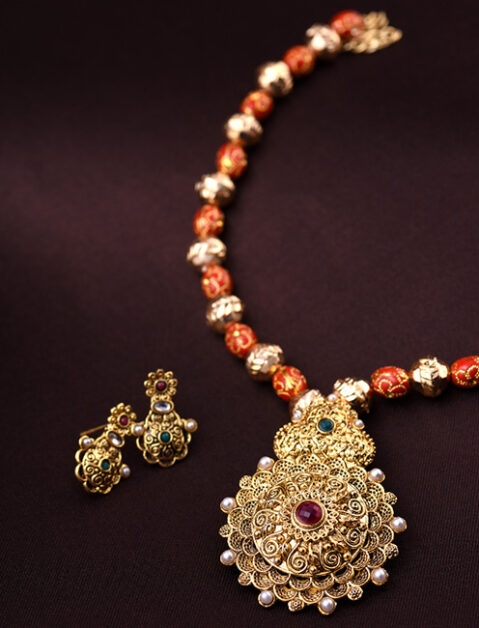
Exploring ‘what is jewelry’ unveils a world of beauty, craftsmanship, and personal expression. Each delicate fashion jewellery in centuries of culture, symbolism, and meaning. Whether it’s a nose ring passed down through generations. Or an elaborate necklace worn by Indian brides, Indian Jewellery tells a story.
Jewellery or Jewelry, this article explores how Indian fashion jewelry isn’t fashion. But a window into the soul of India. The jewellery meaning transcends adornment, embodying stories, traditions, and personal expressions. We’ll uncover the history of Jewelry in everything. From Hindu bride to religious practices. Revealing the stories whispered by each earring, bangle, and Maang Tikka.
So, join us as we embark on a journey to sparkle up your style. Get ready to discover a world of exotic elegance! This mystical Jewelry will make you feel like royalty.
Also Read:
- 7 Proven Skills to Help You Cope with Stress Successfully
- Beyond Trends: Embracing Pioneering Sustainability in the Fashion Industry
- 12 Latest Indian Fashion Trends 2023: Slaying with Chic and Stylish
- Akshaya Tritiya 2024: A Spiritual Guide to the Festival
The Rich History: Traditional Indian Jewelry
The art of Indian Jewellery boasts a vibrant history. Stretching back millennia and evolving alongside the nation’s diverse cultures and artistic traditions.
Indus Valley Civilization (3300-1300 BCE): Early Adornment
The earliest evidence of jewelry-making in India comes from the Indus Valley Civilization. It is one of the world’s oldest urban societies. Archaeological excavations have unearthed terracotta, carnelian, and steatite beads. Suggesting a sophisticated understanding of crafting and adorning the body.
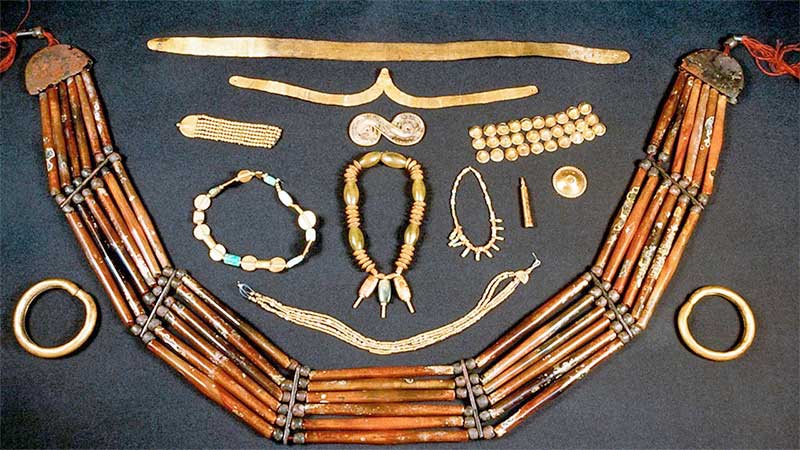
Vedic Age (1500-500 BCE): The Rise of Metals
The Vedic Age saw the arrival of metals like gold, silver, and copper on the jewelry scene. The Vedas, ancient Indian scriptures, mention ornaments like bangles, necklaces, and earrings. These often crafted from these precious metals. The “Yajur Veda” even mentions the use of fire for metalworking. This in itself is a testament to the evolving techniques of the era.
The Mughal Empire (1526-1857): An Era of Opulence
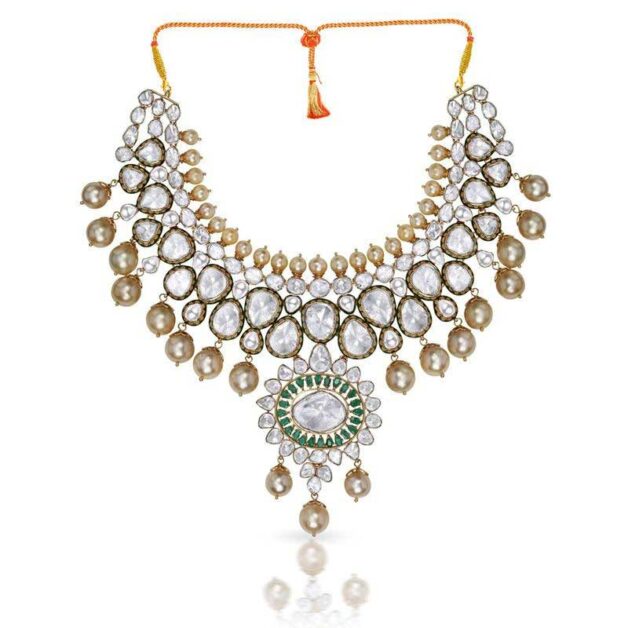
The Mughal Empire ushered in a golden age of Indian Jewellery. Mughal emperors are the patrons of the jewellery craftsmanship. And their love for gems and jewels is evident in the exquisite pieces crafted during this period. Mughal Jewellery art work includes:
- Minakari Work: or Meenakari (Persian: میناکاری). The art of enamelling Jewellery, introducing vibrant colours and intricate designs.
- Gemstone Inlay. Precious and semi-precious stones were set into gold and silver, creating dazzling masterpieces.
- Jadau Work: A gem-setting technique where gemstones use with minimal visible metal. Creating a seamless and luxurious appearance.
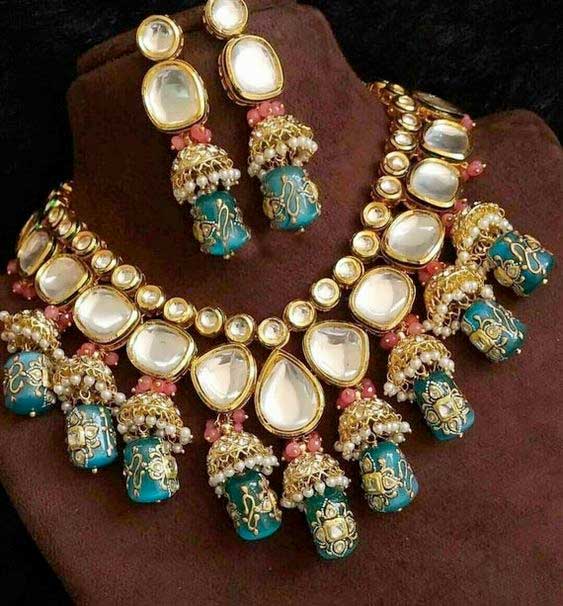
While the Mughals left an undeniable mark. Indian Jewelry has always been a tapestry woven from diverse regional traditions. Today, Indian Jewelry continues to evolve. It remains a cherished part of Indian culture. Adorning bodies, signifying traditions, and serving as treasured heirlooms passed down through generations.
The symbolism of Metals in Indian Jewellery
“Beyond Adornment: The Power of Metals.” It highlights metals’ symbolic and social significance in Indian Jewellery.
Jewellery Meaning. Jewellery or Jewelry refers to decorative items worn for personal adornment. It can be anything from earrings, necklaces, bracelets, and rings. Various materials-precious metals, gemstones, beads and shells is use to craft Indian Fashion Jewelry.
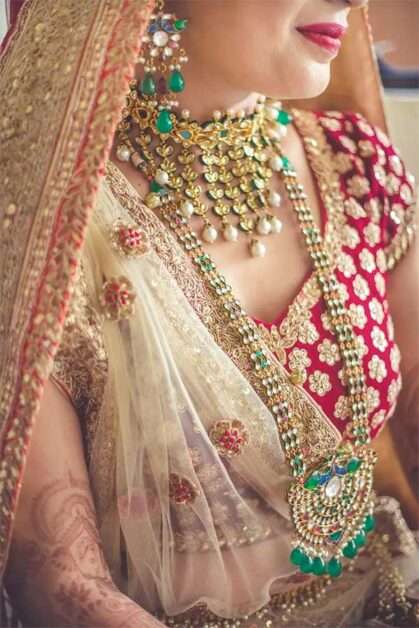
The Symbolic Meanings of Jewellery Materials
As the centuries progressed, the materials used in Indian Jewellery evolved. Each metal imbued with profound meaning.
Gold: Symbol of Prosperity
This warm metal, symbolizes the sun. It represents prosperity, warmth, and even immortality in Hindu culture. Its association with the divine made it a popular choice . Gold finds use in religious ornaments and bridal Jewellery.
Silver: Symbol of Protection
Cooled tones of silver evoked the moon, signifying serenity, purity, and balance. Often used alongside gold. Silver offered a more affordable and versatile option for everyday wear.
Copper: Symbol of Vitality
Copper promote vitality and good health. Prized for its reddish hue. Believed to have healing properties, copper found favor in traditional medicine and amulets. It was also a more accessible metal, allowing wider use of Jewellery across social classes.
Platinum: Symbol of Purity and Strength
A latecomer to the Indian fashion jewelry scene. Platinum’s strength and subtle sheen made it famous for intricate and delicate settings. It offered a modern and sophisticated alternative to traditional metals. It signifies enduring love and commitment.
Diamonds: Symbol of Everlasting Love and Clarity
The hardest natural substance, diamonds signified strength, invincibility, and eternal love. Their brilliance and rarity made them a coveted gem. Often reserved for special occasions and royal adornment.
Precious Stones
Precious gemstones like rubies, emeralds, and sapphires are also incorporated into Indian Jewellery. And has protective powers and aesthetic value. Emeralds represent fertility and new beginnings.
Semi-Precious Stones
Various semi-precious stones like carnelian, turquoise, and lapis lazuli are also used. These stones add color and visual interest to jewellery pieces.
Gemstone Symbolism Across Castes
In Indian tradition, the color of gemstones varies by caste. Brahmins wear white diamonds, symbolizing purity. While Kshatriyas wear red gemstones, signifying power over lower castes. Sudras wear black, reflecting their position, and Baniyas wear yellow, symbolizing prosperity. Gemstone colors indicate caste status and obedience.
Over time, Indian Jewellery has evolved to incorporate new metals, gemstones, and designs. The symbolic and cultural significance remains. Indian fashion Jewelry is a meaningful part of the tradition. And a stunning form of artistic expression.
Traditional Indian Jewelry: Worn Through Life’s Stages
In Indian culture, conventional Indian Jewellery becomes a narrative. Woven into the fabric of one’s life. From the grandeur of a Hindu bride’s attire to the everyday elegance of a working woman. Each piece whispers stories of tradition, heritage, and personal significance.
Childhood: A Sparkly Start
The journey with traditional Indian Jewellery often begins in childhood. Delicate anklets, known as payals, with their gentle chime. Generally worn by an infants for protection and to bring good luck. As children grow, lockets with religious symbols or auspicious gemstones are worn. It brings blessings and well-being.
Wedding Jewellery: A Ceremony of Adornment
The Indian wedding is a dazzling spectacle. And the hindu bride takes center stage. Adorned in a symphony of traditional Indian Jewellery. This Hindu Jewelry isn’t about aesthetics. It embodies the concept of “Streedhan.” Woman’s wealth that empowers her financially and symbolically.
Necklaces like the Rani Haar, crafted from gold and studded with precious stones. It represent prosperity and the blessings bestowed upon the newlyweds. The delicate Maang Tikka, a headpiece adorning the bride’s forehead. It signifies marital union and her entry into a new life. Every bangle, each with its intricate design. Whispers tales of protection and good fortune.
Grooms, too, take part in this ceremony of adornment. A turban adorned with a jewelled brooch. Or a sherwani accented with gold buttons adds a reality to their attire.
Festivals and Rituals: Embellishing Tradition
Traditional Indian Jewelry plays a significant role in specific festivals and rituals. People adorn gold Jewellery during Diwali to usher in prosperity and good fortune. Teej, a monsoon festival celebrated by women, sees them adorned in colorful bangles. Symbolizing marital bliss and seeking blessings for their husbands.
Intricate headpieces worn during Durga Puja to Rudraksha beads used in daily prayers. Fashion Jewellery becomes integral to expressing devotion and celebrating traditions.
Daily Wear Jewellery: For Every Ocassion
Indian Fashion Jewelry continues to be an integral part of everyday life. Women might wear simple gold studs for good health. Or elaborate traditional Jhumkas, signifying their cultural heritage. Nose rings, once a marker of marital status, are now a statement of cultural pride and beauty. Men might wear a simple gold chain or a signet ring. Reflecting regional variations and personal preferences.
This love affair with fashion jewellery continues to evolve. Modern designers are incorporating new gemstones alongside traditional favourites. Contemporary trends find a place in Indian jewellery design. There’s a resurgence of interest in conventional tribal designs. Ensuring that traditional Indian Jewelry continues to adapt. And sparkle in the ever-changing world of fashion
Common Motifs and Design Elements in Traditional Indian Jewelry
Indian Fashion Jewelry is a vibrant tapestry woven with symbolic meaning. Beyond the materials, the motifs adorning these pieces hold deep cultural significance.
Symbolic Motifs and Design Elements:
Nature Motifs. Nature reigns supreme in Indian Jewellery. Floral and faunal designs flourishing across necklaces, earrings, and bangles.
- Peacock: Symbolizes grace, beauty, and love.
- Lotus: Symbolizes celestial beauty, enlightenment, and purity.
- Elephant: Symbolizes wisdom, strength, and prosperity.
- Mango: Represents fertility, love, and prosperity.
Spiritual Symbols: motifs in traditional Indian Jewelry are not visually striking. It also carries profound cultural and religious significance. This makes them highly sought-after by fashion jewellery enthusiasts worldwide.
- Swastika: A sacred symbol representing well-being, good luck, and fortune.
Other Design Elements: Indian Jewellery stands out for its diverse design elements. The elaborate designs are a reflection of a diverse cultural past.
- Floral Patterns: Depict nature’s beauty and symbolize growth, new beginnings, and eternal life.
- Filigree Work: Intricate metalwork featuring twisted threads and tiny beads. Adds a delicate, lacy look to fashion Jewellery.
- Jhumkas: Traditional bell-shaped earrings symbolizing prosperity and happiness. Worn on special occasions.
- Temple Jewelry: Inspired by temple architecture, featuring motifs of deities, gods, and goddesses. Symbolizes devotion and spirituality.
Gemstone Symbolism Across Castes
In the past, the color of gemstones varied by caste. For example, Brahmins might wear white diamonds (purity). Kshatriyas wore red gemstones (power). Vaishyas wore yellow gemstones (prosperity). And Shudras wore black stones (humility).
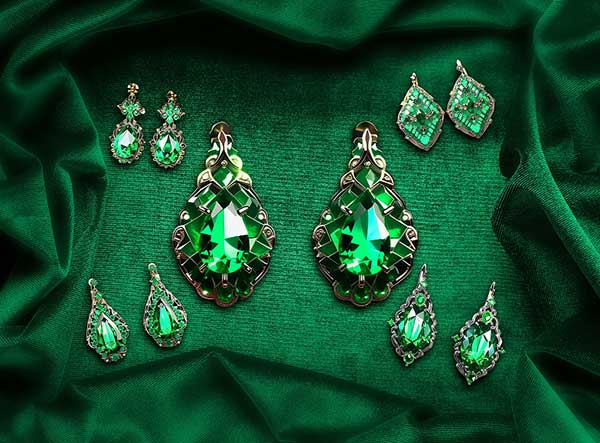
Beyond flora and fauna, geometric patterns like paisleys and mandalas are prominent. Paisleys, with their teardrop shape, represent fertility and abundance. Mandalas, intricate circular designs, symbolize the universe and life cycle.
These motifs are not merely decorative. They are windows into India’s rich cultural and spiritual beliefs. Each piece imbued with meaning and artistry, tells a story waiting to reveal.
A Journey Through India: Regional Variations
India’s rich tapestry extends beyond landscapes and cultures. Weaving its magic into the art of traditional fashion Jewellery. Each region boasts a distinct style, reflecting its heritage and craftsmanship.
North India: Opulence Awakens
Inspired by the Mughal era, North Indian jewellery exudes grandeur. Imagine heavy gold necklaces, gemstone studded bracelets, and chunky anklets adorning maharanis. Elaborate engravings and precious stones: rubies and emeralds bring these pieces to life. The iconic Raani Haar, a thick gold necklace encrusted with pearls and gemstones. All exemplifies exquisite opulence.
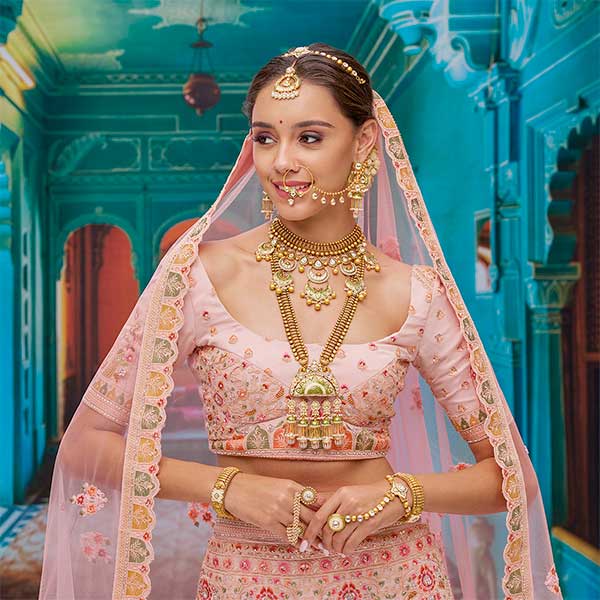
South India: Where Delicacy Reigns
In contrast, South Indian Jewellery embraces minimalism and delicate beauty. Temple jewelry, a true marvel, uses gold and precious stones. To recreate intricate patterns and religious motifs inspired by temple architecture. Pendants depicting deities. Lightweight gold pieces like bangles, chains, and jhumkis are everyday staples.
East India: A Land of Silver and Skill
Venture east to discover a world of handcrafted silver jewellery. Intricate filigree work and embroidery define the styles of Odisha and West Bengal. Colorful beaded necklaces with semiprecious stones add a vibrant touch. Assam’s Bihu dance fashion jewellery features red and white pompoms dangling from silver chains. It reflects the region’s festive spirit.
West India: Diamonds Take Centre Stage
In the west, Gujarat boasts a diamond cutting and polishing hub. Diamond jewelry reigns supreme, from necklaces and earrings to traditional Mangalsutra (marriage symbols). Kundan jewellery, utilizes gold foil and lacquer to embed gemstones. Thus creating a captivating display.
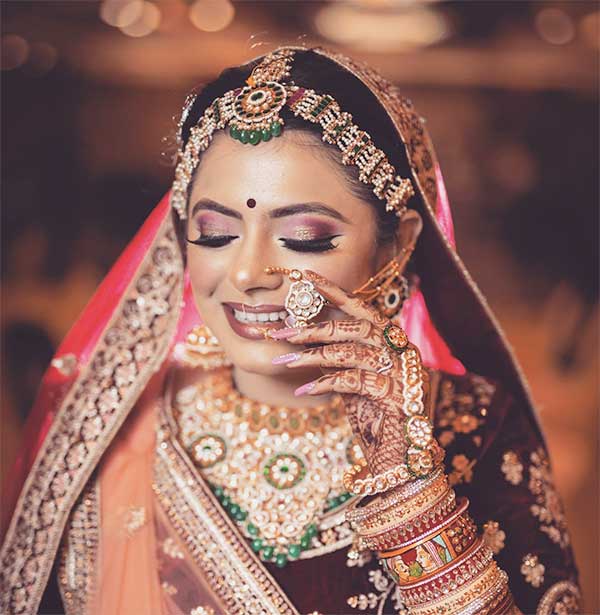
Beyond Regions: Tribal Jewellery
India’s diverse ethnic tapestry is evident in its tribal Jewellery. Each piece, crafted with grass, beads, feathers, and stones, represents a unique identity. The Bastar tribe in Madhya Pradesh creates coin jewellery. The Bhutia tribe in Sikkim favors 24-karat gold. These pieces are adornments and social markers. Signifying age, marital status, and social standing.
Each region’s Indian culture Jewellery tells a story of India’s rich heritage. From the opulent north to the delicate south. This captivating journey now moves beyond materials. We now delve into techniques that breathe life into jewellery.
Craftmanship: Traditional Indian Jewelry
Indian Jewellery transcends the beauty of its materials. It’s a canvas brought to life through the artistry of various techniques. Let’s delve into some captivating methods that weave magic into each piece.
Enamel Jewellery (Minakari)
Imagine vibrant colors dancing on gold! Minakari, an enamelling technique in Rajasthan. Achieves this magic by fusing powdered glass onto the metal surface. Delicate floral or geometric patterns emerge. Adding a dazzling pop of color to traditional pieces. While pink, red, green, and blue hold a timeless charm. Vibrant orange and yellow have recently become popular additions.
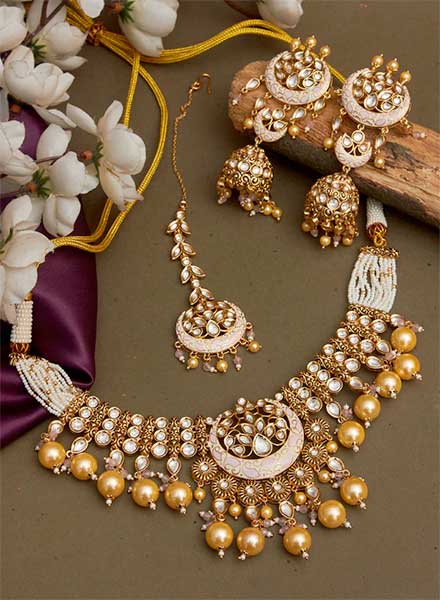
Beadwork Jewellery
This meticulous art form involves weaving tiny beads. Crafted into intricate patterns from gold, gemstones, or even glass. Seen in tribal and folk Jewellery from regions like Gujarat, Rajasthan, and South India. Beadwork is a testament to the patience and skill of the craftsperson. Coral and turquoise beads, in particular, have protective powers. Adding a deeper layer of meaning to these stunning creations.
Filigree Jewellery
Delicate as a dream. Filigree work transforms silver or gold wires into mesmerizing openwork designs. Imagine intricate lace patterns crafted from metal! This art form, prevalent in Andhra Pradesh, Odisha, and West Bengal. It results in light, airy, and beautiful Jewellery. From pendants and bracelets to anklets and hair ornaments. Filigree work elevates each piece into a work of art.
Bells Jewelry
The gentle chime of bells is not just a pleasant sound; in Indian Jewellery, it serves a symbolic purpose. Tiny gold or silver bells are often attached to anklets, bracelets, necklaces. This tinkling sound ward off evil spirits, offering stress-free living to the wearer. Particularly popular in bridal Jewelry and adornments for dancers. The divine resonance of hese bell jewelry add a touch of magic and cultural significance to each piece.
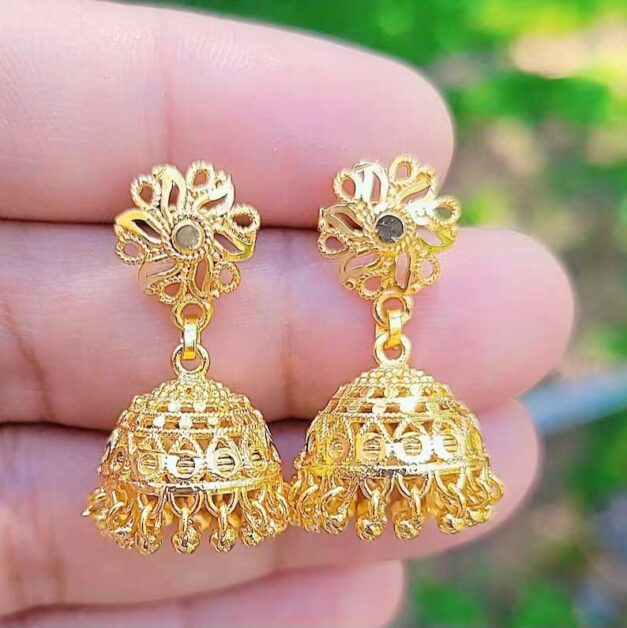
These are a few examples of the artistry into creating traditional Indian Jewellery. Each technique, meticulously practiced for generations, breathes life into the materials. Whether gemstones, enamel, beadwork, or filigree. Traditional Indian Jewelry is a feast for the eyes. Every element carries spiritual and cultural symbolism. Thus telling a story of this rich heritage.
Religious Symbolism in Traditional Indian Jewelry
The connection between Hindu Jewelry and religious beliefs in India runs deep. Indian Jewelry is deeply intertwined with religious beliefs and practices. Deities, Lord Shiva, Vishnu, Shri Ram, Shri Krishna, and Goddesses adorn elaborate jewellery. Symbolizing the divine nature and importance of Indian culture Jewelry.
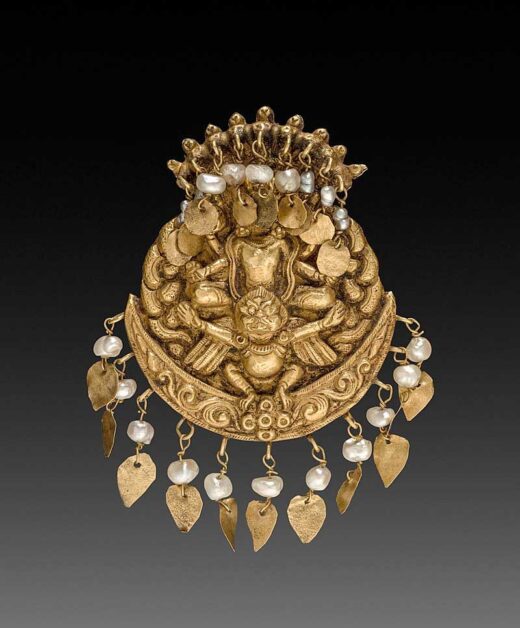
Divine Adornments
Jewelry has long served as a symbol of faith. Each religion incorporating unique designs and symbols into their adornments.
- Christianity. Pendants with the chi-rho monogram and the cross symbolize faith, humility, and strength.
- Hinduism. Rudraksha beads, a type of natural seed worn as a necklace, hold immense significance. Om pendants bearing the sacred Hindu symbol represent the universe and spiritual enlightenment.
- Islam: Muslims wear lockets for protection, evoking happiness, devotion, and joy.
- Sikhism. The kirpan pendant symbolizes readiness for self-defense. Khanda pendant represents God’s universal and creative power.
This brief exploration of the history of traditional Indian Jewellery lays the groundwork. For a deeper dive into its enduring significance in Indian culture and tradition.
Adornment with Meaning: The Symbolism of Traditional Indian Jewelry
Every piece of traditional Indian Jewellery tells a story. A language woven into the fabric of Indian culture. Each piece whispers stories of tradition, heritage, and personal significance. Let’s delve into the symbolic meanings of the most common pieces. Each worn across the vast landscape of India.
Head Jewellery (Maang Tikka/Matha Patti)
The Maang Tikka, a delicate headpiece adorning the hindu bride forehead. It symbolizes marital union and her entry into a new life. Head Jewellery often embellishes with pearls or gemstones. This hindu jewelry adds a touch of elegance and signifies the blessings bestowed upon the newly weds.
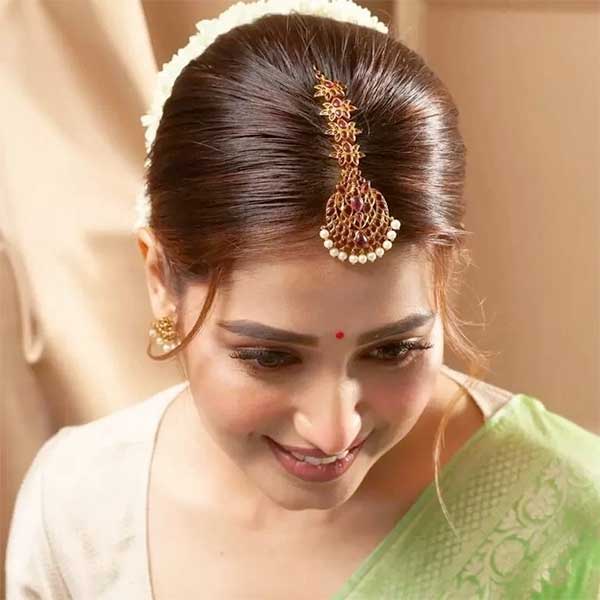
Earrings (Karas/Jhumkas)
Earrings, known as karas or jhumkas, hold a special place in Indian Jewellery. Small studs represent good health. While elaborate danglers symbolize a woman’s cultural heritage and social status. This heritage jewellery is worn by both men and women. Earrings add a touch of elegance and cultural pride.
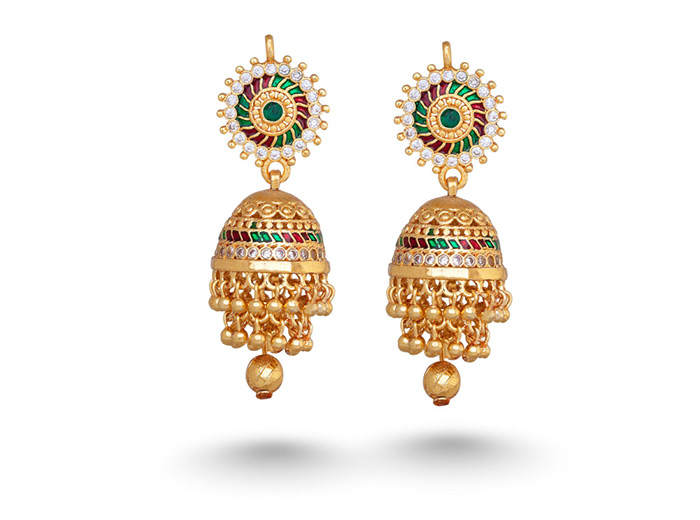
Nose Pin (Nath)
The nose pin, or “Nath”, holds both cultural and social significance. Worn by married women, it has become a cultural pride and beauty statement. The design and placement of the nose pin can also vary by region.
Necklace (Mangalsutra/Haars)
Necklaces, like the Rani Haar or the Mangalsutra, for various reasons. This hindu jewellery can represent prosperity, marital bliss, or religious devotion. The elaborate craftsmanship and materials often reflect the social status and regional traditions.
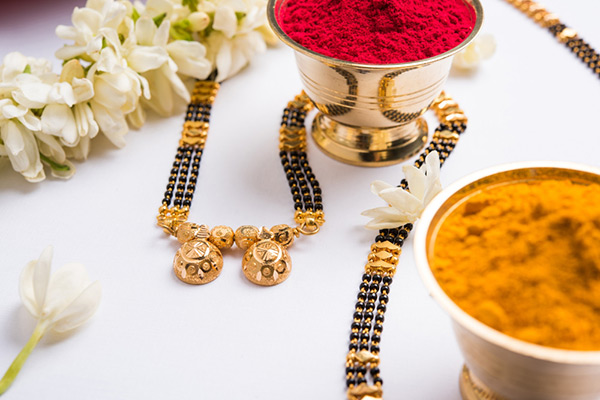
Bangles (Choodiyan, Kada or Payal)
Bangles are worn in multiples on both wrists. It represent joy, marital status, and cultural heritage.
The materials and designs vary by region. Gold bangles signify prosperity. They are believed to bring good luck and ward off evil spirits.
Armlets (Bajuband)
Traditionally worn by men and women, Bajuband symbolizes strength, protection, and social status. In some regions, they hold medicinal properties.
Anklets (Payal)
The rhythmic sound of payal bells is believed to ward off evil spirits and bring positive energy. They also symbolize a woman’s marital status and social standing.
Each piece whispers a story from head to toe, connecting the wearer to their heritage and traditions. As the world of fashion evolves, so too does Indian jewellery design. Contemporary jewellery designers are reinterpreting traditional motifs and incorporating contemporary trends.
A Modern Embrace: The Evolution of Traditional Indian Jewelry
The world of traditional Indian Jewelry is not static. It’s a living tradition that constantly evolves to suit contemporary tastes. Fashion jewellery adds flair to outfits, reflecting personal style elegantly. Here’s a glimpse into how this captivating art form is adapting to the modern world:
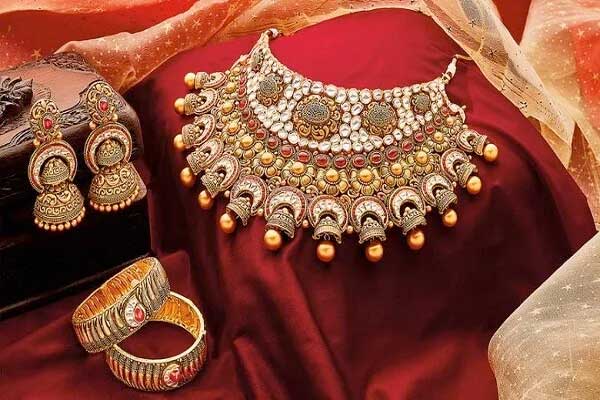
Evolution of Designs
Jewellery designers are adding contemporary lens in the latest fashion jewellery. Geometric patterns and clean lines are finding their way onto elaborate necklaces and earrings. While bold gemstone combinations add a touch of modern flair. The use of lighter materials makes traditional pieces more comfortable for everyday wear.
Fusion Jewelry
The boundaries between traditional and modern are blurring with the rise of fusion jewellery. Imagine a sleek pendant crafted from gold, adorned with a delicate kundan Jewellery. These pieces seamlessly blend the timeless elegance of traditional designs with contemporary aesthetics. This appealing to a broader audience.
Globalization’s Influence
The world is now more interconnected, which has impacted the production and consumption of Indian Culture Jewellery. Designers are incorporating global trends and gemstones from around the world. Accessibility has also increased, with online platforms. Allowing artisans from remote Indian villages to showcase their work.
The history of Jewelry remains relevant for generations to come. Indian Fashion Jewellery is a beautiful testament to the enduring legacy of this art form. Heritage and modernity of Indian culture and tradition combine to create stunning pieces. Pieces of Indian jewelry traditions that resonate with the contemporary world.
Also Read:
- Indian Fashion Trends 2023: Bollywood makes a Statement
- Brew a Better World: The Secrets of Timeless Traditions
FAQ: Traditional Indian Jewelry
What is Jewelry?
The term ‘Jewellery or jewelry’ comes from the Latin word ‘Jocale,’ meaning plaything. It refers to decorative articles worn for personal adornment. The first known jewellery, dating back 100,000 years, was discovered by archaeologists, consisting of Nassarius shell beads.
What are the different types of traditional Indian Jewelry?
There are many kinds, including necklaces like Mangalsutras and hearts, bangles like kangan and kadas, earrings like jhumkas and chandbalis. Rings like anguish, nose rings like this, toe rings, anklets, and hair ornaments like tikkas. Each region of India has its unique designs and styles.
What do the different pieces symbolize?
Necklaces signify protection and prosperity. Nose rings indicate marriageability. Earrings promote health and fertility. Bangles bring good fortune. Rings represent eternity and commitment. Hair ornaments invoke the blessing and ward off evil. Toe rings increase female energy. Anklets tinkle to ward off spirits.
How should I wear traditional Indian Jewelry?
Most pieces are worn in combination for maximum symbolic effect. Necklaces, earrings, nose rings, bangles, rings, and hair ornaments are commonly worn together for weddings and festivals. Toe rings and anklets are usually only worn by married women. Fashion Jewelry is also often layered, with multiple necklaces, several bangles on each arm, and rings on most fingers.
Where can I buy authentic traditional Indian Jewelry?
For the highest quality and most symbolic pieces, buy from jewelers in India who specialize in traditional designs. Many MMTC Authorised distributors also ship worldwide. Look for 22-24 karat gold, Gemstones like rubies and emeralds, and classic patterns for the most authentic looks.
Conclusion
So there you have it – Fashion Jewellery has its unique and special place in Indian culture and tradition. Traditional Indian Jewelry transcends mere adornment. From the elaborate pieces that Hindu bride wear to the simple bangles that adorn business women’s wear.
From the rich symbolism embedded in materials and motifs. Indian Jewellery is about so much more than just enhancing beauty. Jewellery meaning represents family, status, spirituality, and unity. From the history of Jewelry to the regional variations. Hindu jewellery reflects diverse craftsmanship. Indian Jewellery art form continues to evolve.
Contemporary Jewellery designers reinterpret traditional designs in Indian fashion jewelry while globalization fosters a beautiful exchange of styles. As tradition embraces modernity, Indian Culture Jewelry ensures its enduring legacy for generations.
Appreciate these treasures for jewellery or Jewelry, and their outward sparkle and shine.
Share your Review
Our Digital Imprints:
Social Media Influencer:Trendvisionz – A Premier Digital Marketing Agency in India
Get Connected to us with our Newsletters-Transforming Lives… Creating the magic. Just – Believe ~ Practice ~ PerformBizTech Chronicle… Navigating Tomorrow’s Tech Frontiers 🚀
Join my LinkedIn Group: Digital Marketing, Content Creation World Group
Follow me on Twitter or LinkedIn. For More Such Article subscribe to Trendvisionz!
